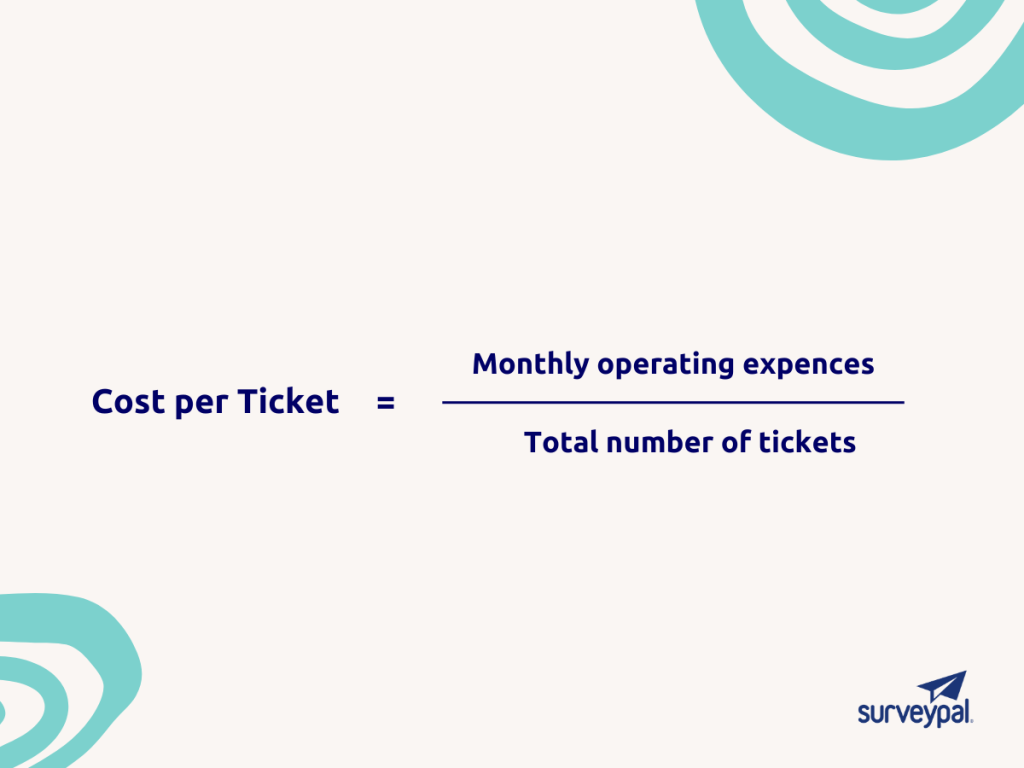Cost per ticket (CPC) is an often overlooked but crucial factor when evaluating contact center performance. It measures the total cost of resolving each ticket, including labor costs and any additional costs for external services or third-party products.
If you know the cost of a movie ticket, a gallon of gas, or even a cup of coffee, why not the cost of each ticket your service desk processes? Understanding what drives costs and implementing measures to reduce them improves efficiency and service delivery.
Cost per ticket optimization requires a comprehensive review of the entire customer support process. A key question to consider is whether the cost of a ticket is within an acceptable threshold established by the organization. Once you determine the cost of a ticket, there are several ways to reduce it.
Understanding the Cost Per Ticket
Cost per ticket is calculated as a mean average, not a median average. It is considered one of the foundation metrics of customer service and comes down to cost containment and the quality of service your business provides. If your service desk is effective, you should reap a return on investment of $3 for every $1 you invest.
The ticket is the unit that your service desk uses to track customer support requests. Every ticket contains a description of the incident, data on the resolution, and a log of any changes or updates applied to the request.
Measuring how efficiently your service desk performs its tasks can be a game-changer to your business. Sometimes it may be higher than average, but this is okay if your support quality levels are also higher.
What is Cost Per Ticket?
Cost per ticket refers to the monthly operating expense of a customer service department divided by the number of tickets resolved in that period. The cost of one ticket includes labor costs and any related expenses associated with resolving it.
Using only customer satisfaction to measure success can be subjective. An accurate measure should consider customer satisfaction and cost per ticket.
A company may be comfortable with a higher cost per contact if it generates a higher customer satisfaction rating. Your business should calculate the cost per customer service contact to determine if it’s increasing or decreasing and adjust accordingly.
How to calculate your Cost Per Ticket
Calculating the cost per ticket for your service desk is simple. You must calculate your total monthly operating expense and divide it by the monthly ticket volume.

Factors that affect CPT
Including your total operating service desk cost is the best way to guarantee the accuracy of your average cost per ticket. You need to measure all your service desk running costs which may include various items such as:
Service desk and indirect personnel salaries and benefits
You should budget your service desk agents’ salaries and other benefits. Include the salaries of any direct or indirect personnel involved in the ticket resolution process.
Technology and telecommunications
The service desk area comprises various hardware to receive and resolve customer complaints. This includes desktop computers, analytics tools, servers, data centers, software licenses, and reporting tools.
The team working here also requires telecom headsets, an Automatic Call Distributor, VOIP hardware and software, and Interactive Voice Response. These are critical to any service desk operations to offer excellent customer service.
Facility and office supplies
Where is your service desk in the company located? How much is the lease payment for that specific office space? You should include the cost of getting your employees an area to work in.
This area will also require regular office utilities, daily cleaners for good hygiene, and common maintenance fees such as repainting and utility upgrades.
Other costs
The costs you incur from your service desk heavily rely on how your business operates. The expenses for Company A, a plastic manufacturing company, will differ from that of Company B, a traveling agency.
Other costs your service desk may incur include travel, legal and consulting fees, software licensing fees, meals and refreshments, property taxes, and job training. These will depend on what service you offer and how you offer it.
Average Cost Per Ticket Across Industries
The average cost per ticket is $22, but this figure differs across various industries. Some companies’ costs can go as high as several hundred dollars, while others are under $10. Let us look at multiple industries and their cost per customer service contact:
| Industry | Average Cost per Ticket |
|---|---|
| Retail | $5 – $15 |
| Technology | $25 – $35 |
| Telecommunications | $20 – $25 |
| Healthcare | $50 – $60 |
| Financial services | $10 to $25 |
Retail
Retail industry customer service operations are less costly and range from $5 to $15. However, some big retail companies may have a higher CPT.
Technology
Technology or IT companies are among the most expensive in terms of cost per ticket. The operations require advanced technology and skilled labor, making these service desks the costliest.
The CPT can range from $25 to $35; some companies can even pay as high as $100, depending on how they run their operations.
Telecommunications
The telecommunications industry has a range of $20 to $25 for their CPT because of their outsourcing labor costs and third-party vendor fees. They must also pay their licensing fees, making this industry highly expensive.
Healthcare
The healthcare industry has the highest cost per ticket as they must pay for their skilled labor and top-of-the-line technology. It is estimated that the cost per customer service contact is around $50 to $60, but some big hospitals and clinics have a fee as high as $100.
Financial services
Banks, credit unions, and other financial services spend less on their service desk as they only require little human resources. Their CPT can range from $10 to $25, with some larger companies spending up to $50.
Importance of Tracking Your Cost Per Ticket
If profitability is important to your business, you should track how much you spend to resolve your customer requests. They help you make better-informed business decisions and increase your business’ success.
Here are some reasons why tracking this service desk metric is beneficial to your business:
Make data-driven decisions
The best business decisions are those based on specific data such as sales, cost per ticket, departmental expenses, etc. Tracking your expenses puts the information you need to make business decisions in one place, making it easily accessible.
You can, for example, make decisions such as training employees who perform below your expectations. It also helps you identify which departments are flooded with service requests and allocate more help there.
Identify areas for improvement in customer service
There’s always room for improvement in how you do things for a better result. Even a slight change in how your service desk conducts its tasks can yield better customer satisfaction or lower operating costs while maintaining a good performance.
Collecting your cost per ticket helps you identify which sections of your customer service operations are failing. You can allocate more resources or employees to the affected areas for improvement.
Manage costs and increase revenue
The financial benefits of tracking the cost per ticket are obvious. You can see where your team spends a lot of time and business funds.
This allows you to better budget for projects and payrolls by managing your revenue appropriately. You can also maximize your income by ensuring all tickets are resolved effectively while at a minimal cost.
Strategies to Lower Your Cost Per Ticket
A high cost per ticket does not always mean your customer service is performing poorly or well. The cost should be equivalent to the level of customer satisfaction you provide.
If your cost per contact is too high and does not equate to customer satisfaction, you can deploy some strategies to lower it. Those strategoes include:
Self-service options (FAQs, Knowledge Bases, Chatbots)
A self-service knowledge base, community forums, FAQs, and chatbots to help answer customers’ questions can significantly lower ticket volume. Customers don’t have to reach out to your agents when they can solve their problems with the available self-service options.
This is one of the most tested and true method for reducing the volume of inbound support requests. It also helps you reduce the number of agents you need to man your contact center.
Automation
Businesses can leverage automation technologies such as robotic process automation (RPA), machine learning, and natural language processing (NLP) to automate most routine support tasks.
Intelligent automated ticket routing can help categorize and prioritize tickets based on urgency and impact. This reduces the need for human intervention, allowing agents to focus on other critical tasks.
Chatbots and virtual assistants can help customers with repetitive tasks such as password resetting or providing troubleshooting instructions.
Training & coaching customer service representatives
One of the most obvious ways to reduce your CPT is to empower your employees to be more effective. If you have to hire additional support, your cost will go up. Retain your customer service representatives and invest in coaching and training them to efficiently perform their tasks.
Ensure they can effectively use your setup, which includes hardware and software while providing excellent results. If you introduce an update, ensure they all get adequate guidance on how to keep operating.
Optimize agent utilization
Agent utilization refers to the percentage of an agent’s productive time out of their capacity. Agent utilization is a productivity metric which ultimately determines how long an agent works during the day and how they perform.
It gives you an insight into what you need to improve their productivity and subsequently help achieve your business objectives.
Here are some ways to optimize your agent utilization:
Deploy the right tools
You have won half the battle if you have the right tools at hand. Provide your agents with streamlined tools that provide everything they need for maximum productivity.
Your service desk software should be up-to-date and have the necessary features to assess and display tickets easily. Some must-have features for reliable software include workflow automation, task tracking, customer service analytics, and customer relationship management (CRM).
Create a conducive workspace for agents
The workspace should be comfortable enough to encourage collaboration and innovation. Ensure you have the essential tools and a positive atmosphere where employees can operate comfortably.
The office space should have good airflow and drinks and snacks for refreshment every once in a while. Consider adding height-adjustable office desks that foster an ergonomic workstation.
Monitor agent performance
Monitoring your agents’ performance helps keep track of their output and how they handle customer support requests. You can use analytics software to ensure they maximize their working hours.
If they’re set up in an area with favorable working conditions, you will unlikely have problems with dedicated employees. You can lay off or replace those who fail to perform effectively.
Monitoring and analyzing customer service interactions
How an agent interacts with customers plays a significant role in customer satisfaction. You should monitor the channels your agents use to interact with customers to gather information on improving customer satisfaction while lowering cost per customer service contact.
Here are a few tips to help you successfully monitor customer service interactions:
Track all interaction channels
Pay attention to all modes of communication despite having few contact requests. Every channel, whether email, call, chat, or SMS, has information to help you understand your customer’s concerns.
You can use text analytics to automatically monitor customer service conversations and extract valuable insights that provide you with context and allow you to extract customer sentiment. The more in-depth analysis you conduct on all channels, the better you understand which processes require improvement.
Regular channel maintenance
Every channel your customer uses to reach you should be open during working hours. Customers often get frustrated when they try out a company’s various communication channels to air their grievances without a response.
With 78% of customers backing out of a purchase due to poor customer service experience, you must find ways to streamline your operations. Hire professionals for maintenance services to ensure the technology is working and your system can keep up with the demand.
Ask for feedback from customers
Your customers are your best option for discovering the truth about how you serve them. It is imperative to ask their opinion on the level of support quality they received and whether they have any recommendations for improvements.
Reach out to those with difficult ongoing service cases and ask them questions about their problem. Make it a habit to contact them to show that you value their loyalty to your company.
Investing in technology
Customer service is a platform for businesses to respond to their customer’s concerns and a potential sales-generating method. That is why you should leverage high-quality technology to maximize its effectiveness.
Let us look at some of the effective technologies you should adopt for your IT service desk:
Ticket managing systems
A help desk ticketing system software tracks customer issues allowing your agents to solve them promptly. It makes it easier to track open cases and remain on schedule.
A reliable ticket managing system should have notification capabilities and notify users whenever a ticket is created. It can also have an automated alert notifying your agents whenever an unresolved ticket conversation goes silent.
Knowledge management systems
Knowledge management systems allow you to collect, write, and publish information through a customer portal. You can use it to provide your customers with a self-service option for solutions about your products and services.
A knowledge management system can significantly lower your service desk phone call volumes and emails. This improves your team’s efficiency while reducing their workload.
Analytics
You can deploy technology to generate insights by analyzing ticket processes and responses. This will help you understand what issues your agents spend most of their time on and how to improve your systems for smooth operations.
Customer servive analytics platforms enable you to optimise customer service performance by transforming your quantitative and qualitative support data into actionable insights. These insighst should be the first step towards improving the customer experience but also by help you identify the root cause of common issues facing your service desk operations. You can use this information to adjust and solve more severe problems.
Shared inbox software
A system with shared inbox streamlines operations by encouraging collaborations and workflows. It makes it easier to analyze, track, and handle customer issues.
Shared inbox software can allow you to automate handling and replying to specific customer queries and concerns. You can delegate and manage tasks in real time while giving users easy access to customer information.
Customer relationship management (CRM)
CRM software is critical for building and using a database for customer interaction. It can help you send automated emails and resolve customer complaints effectively.
Effective Customer Relationship Management makes it easy for businesses to track lead and customer interactions and optimize sales processes. Knowing your customer’s behaviors and needs helps you pivot to meet them.
Best Practices for Improving CPT
Improving customer experience and reducing support costs should go hand in hand. When it comes to measuring CPT, businesses must be aware of how it correlates with other customer service KPIs. This includes customer satisfaction, Net Promoter® Score, average resolution time, etc.
Reducing the cost of support is important, but you should do it with care. You should not sacrifice customer service quality to reduce costs.
To ensure you get the best value for your efforts, analyze how they will impact customer experience. Look for areas to cut service desk costs that don’t result in worse customer service quality. Here are some best practices you should follow:
Reduce your wait times
Your wait time refers to the time a customer service representative takes to respond to a customer’s inquiry. Reducing your wait times can result in improved CPT, lowering your overall support costs.
You can use strategies such as employing more customer service agents and utilizing automated responses to lower your wait times. You can also invest in high-quality training for your agents to ensure they can handle customer inquiries on time.
Improve your First Contact Resolution (FCR)
Your First Contact Resolution is the percentage of customer tickets resolved on the first contact. The more customer inquiries you can resolve on the first contact, the less time and money you will spend on follow-up calls.
To improve your FCR, invest in tools to help your agents quickly identify and resolve customer issues. You can also employ strategies such as providing self-help resources to your customers or investing in quality customer service training for your agents.
Streamline the customer service process
The best way for business owners to understand how the customer service process works is to take the journey themselves. Go through a typical customer complaint keeping your eyes out for pain points such as slow-loading web pages and delayed replies.
Your pain points lead to angry calls and customer emails to your service desk. Make changes to streamline your processes based on actual research and not assumptions.
Provide proactive customer service
Only 21% of consumers trust global brands to store their information safely. The lack of trust is rising due to increased data privacy issues, breaches, and spam galore. Companies must become proactive in customer service to build customer trust.
Proactive customer service is about anticipating buyers’ problems and needs before they address you for assistance. These may include shipping delays, service interruptions, product recalls, etc.
Proactive customer service allows you to build trust by providing information before customers ask. You can also introduce customers to new products or services they may enjoy. Call or email them detailing the product and include a coupon to incentivize them.
Wrapping Up
CPT is different for every business, depending on the services you offer. It indicates how your agents respond to customer complaints reaching the service desk.
Most businesses try to lower their cost per ticket to save on revenue. However, you should be fine with your CPT generating a higher customer satisfaction rating.
Tracking your CPT provides insight into making data-driven decisions, managing costs, increasing revenue, and improving your overall business performance.
Did you like the post?
You might also like:

Surveypal
Everything you need to lead and improve your customer experience. Learn more at surveypal.com, or







